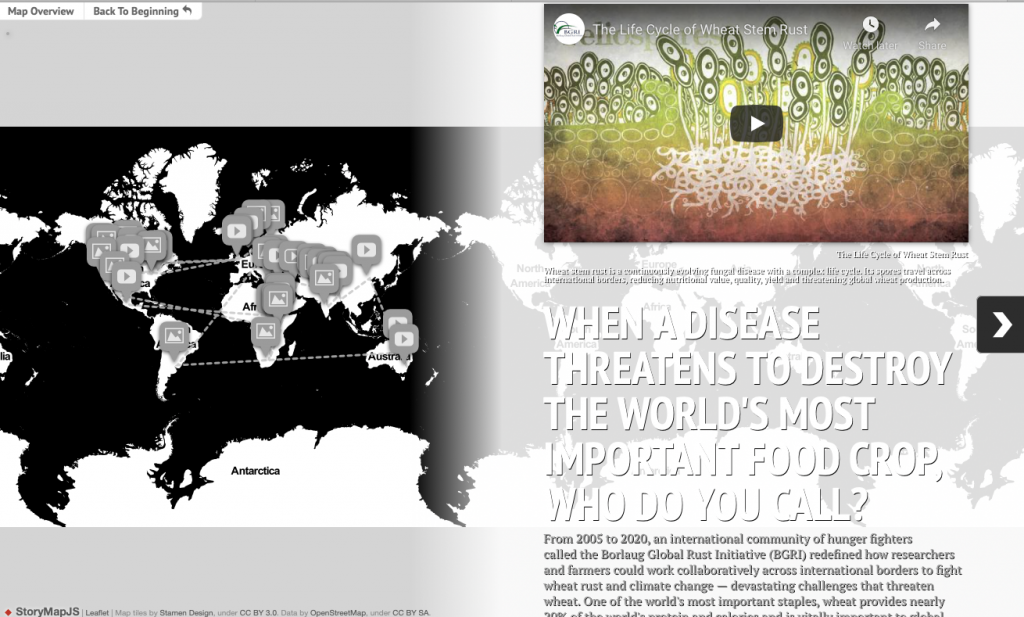When a Disease Threatens to Destroy the World’s Most Important Food Crop, Who Do You Call?
New interactive map illustrates impacts of 15 years of collaboration for disease- and climate-resilient wheat
By Linda McCandless

In 2005, preeminent wheat breeder and Nobel Laureate Norman E. Borlaug sounded the alarm to bring the world’s attention to the outbreak of a new variant of stem rust, Ug99, that threatened to wipe out 80% of the world’s wheat.
The result was the Borlaug Global Rust Initiative (BGRI), a global community that pioneered innovative ways for scientists and smallholder farmers around the globe to collaborate on meeting challenges brought about by wheat disease and climate change.
As a founding member of BGRI, the International Maize and Wheat Improvement Center (CIMMYT), and, later, the CGIAR Research Program on Wheat, played a crucial role in the core work of the initiative, leading breeding and large-scale international testing to develop disease resistant wheat varieties, coordinating closely with longstanding national partners of CIMMYT to facilitate the release and spread to farmers of the varieties, and contributing to critical disease monitoring and tracking initiatives.
The BGRI has documented these efforts and related resources in a newly released interactive story map, “Inside the Global Network Safeguarding the World’s Wheat from Disease and Climate Change.” The map highlights the BGRI’s efforts from 2005 to 2020 to introduce climate-resilient, disease-resistant wheat to resource-constrained wheat growers around the world, especially in sub-Saharan Africa and South Asia.
The map highlights work undertaken by scientists on the front lines of the Durable Rust Resistance in Wheat (DRRW) and Delivering Genetic Gain in Wheat (DGGW) projects from 2005 to 2020. These achievements formed the foundation for the work that continues today under the auspices of the CIMMYT-led Accelerating Genetic Gains In Maize and Wheat for Improved Livelihoods (AGG) project.
BGRI scientists from more than 22 national and international agricultural research centers infused resilience into wheat and largely staved off large-scale rust epidemics, working with farmers in East Africa, South Asia and other important bread baskets of the world. The BGRI community improved breeding pipelines, created the world’s most sophisticated pathogen surveillance network, increased capacity in germplasm testing nurseries while conserving and sharing genetic resources, and training new generations of young scientists.
Through videos, photos, interviews, journal articles, blogs, news stories and more, the story map explores the multifaceted work from hunger fighters in Mexico, Kenya, Ethiopia, Nepal, India, Australia, Canada, China, the United Kingdom, the United States, Russia and more.
Written and produced by BGRI cinematographer Chris Knight and associate director for communications Linda McCandless, the map is linked to multi-media and resources from contributors around the world.
The DRRW and DGGW projects received funding from the Bill & Melinda Gates Foundation, the UK Foreign, Commonwealth and Development Office, national research institutes, and Cornell University.
Accelerating Genetic Gains in Maize and Wheat for Improved Livelihoods (AGG) brings together partners in the global science community and in national agricultural research and extension systems to accelerate the development of higher-yielding varieties of maize and wheat — two of the world’s most important staple crops. Funded by the Bill & Melinda Gates Foundation, the UK Foreign, Commonwealth & Development Office (FCDO), the U.S. Agency for International Development (USAID) and the Foundation for Food and Agriculture Research (FFAR), AGG fuses innovative methods that improve breeding efficiency and precision to produce and deliver high-yielding varieties that are climate-resilient, pest- and disease-resistant, highly nutritious, and targeted to farmers’ specific needs.
Research reported in this story was supported by the Foundation for Food and Agriculture Research under award number – Grant ID: COTF0000000001. The content of this publication is solely the responsibility of the authors and does not necessarily represent the official views of the Foundation for Food and Agriculture Research.




